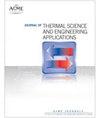EXPERIMENTAL INVESTIGATIONS ON EFFECT OF ORIENTATION ON THERMAL PERFORMANCE OF A NOVEL PCM-BASED HEAT SINK
IF 1.4
4区 工程技术
Q3 ENGINEERING, MECHANICAL
引用次数: 0
Abstract
This paper reports the experimental heat transfer results of a novel PCM-based heat sink coupled with a heat pipe under different orientations. The experiments are conducted at a constant fill ratio of 99% on several heat sink configurations, such as a heat sink (i) with the stem at the center, (ii) with four fins, and (iii) with three longitudinal fins coupled with a heat pipe. The aluminium-made heat sink having an outer diameter of 58 mm and a height of 55 mm with a wall thickness of 4 mm, is used for all the heat sink configurations. The heat pipe with an evaporator length of 60 mm and a condenser length of 40 mm is attached at the center of a three-fin heat sink configuration. Experiments are performed on different heat sinks with n-eicosane as PCM at different orientations of 0, 45, 90, 135, and 180 degree; at various power levels. The heat input is varied between 6 and 12 W. The condenser section of the heat pipe is cooled under two different conditions, i.e., (i) natural and (ii) forced convection. The results show that the finned heat sink coupled with a heat pipe (FHSHP) gives the best charging and discharging performance compared to other configurations. Moreover, it is observed that the performance of an FHSHP is orientation-dependent. Further, the overall effectiveness of FHSHP is high when the condenser section of the heat pipe is cooled using forced convection rather than natural convection.取向对新型pcm基散热器热性能影响的实验研究
本文报道了一种新型的基于pcm的热管耦合散热器在不同方向下的换热实验结果。在恒定填充率为99%的情况下,对几种散热器结构进行了实验,如(i)中心有阀杆的散热器,(ii)有四个翅片的散热器,(iii)有三个纵向翅片和热管耦合的散热器。铝制散热器外径58毫米,高55毫米,壁厚4毫米,用于所有散热器配置。蒸发器长度为60mm,冷凝器长度为40mm的热管连接在三翅片散热器配置的中心。以正二糖烷为PCM,在0、45、90、135和180度不同方位的散热器上进行了实验;在不同的功率水平。热输入范围为6 ~ 12w。热管的冷凝器段在两种不同的条件下进行冷却,即(i)自然对流和(ii)强制对流。结果表明,翅片式散热片与热管耦合散热片的充放电性能较好。此外,FHSHP的性能与方向有关。此外,当热管的冷凝器部分使用强制对流而不是自然对流冷却时,FHSHP的整体效率很高。
本文章由计算机程序翻译,如有差异,请以英文原文为准。
求助全文
约1分钟内获得全文
求助全文
来源期刊

Journal of Thermal Science and Engineering Applications
THERMODYNAMICSENGINEERING, MECHANICAL -ENGINEERING, MECHANICAL
CiteScore
3.60
自引率
9.50%
发文量
120
期刊介绍:
Applications in: Aerospace systems; Gas turbines; Biotechnology; Defense systems; Electronic and photonic equipment; Energy systems; Manufacturing; Refrigeration and air conditioning; Homeland security systems; Micro- and nanoscale devices; Petrochemical processing; Medical systems; Energy efficiency; Sustainability; Solar systems; Combustion systems
 求助内容:
求助内容: 应助结果提醒方式:
应助结果提醒方式:


